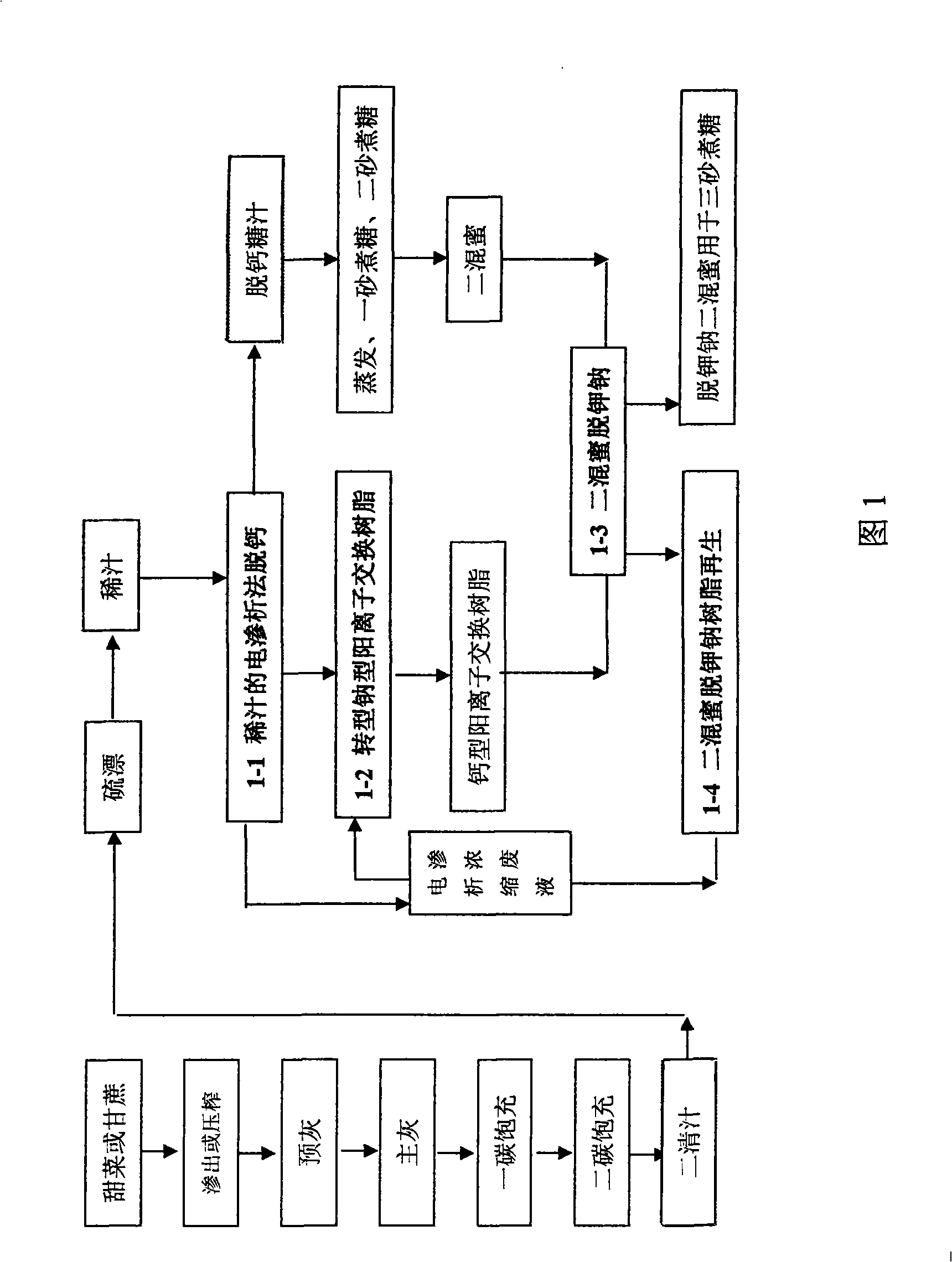Regeneration method for di-mix honey de-kalium-sodium resin
A sodium resin and potassium removal technology, which is applied in ion exchange regeneration, chemical instruments and methods, purification using ion exchange materials, etc., can solve the problems of consuming a lot of manpower and material resources to clean the evaporation tank, affecting heat transfer, and large energy loss. Achieve the effects of saving boiler cleaning costs, improving regeneration efficiency, and saving heat energy
- Summary
- Abstract
- Description
- Claims
- Application Information
AI Technical Summary
Problems solved by technology
Method used
Image
Examples
Embodiment 1
[0022] As shown in Figure 1, a kind of regeneration method of two mixed honey depotassium sodium resins, comprises the following steps:
[0023] (1) After the beets are shredded, the purity of beet thin (sugar) juice is greater than 90%, and the Brix is 14°Bx , Ca 2+ The content is 270mg / L. The dilute (sugar) juice is decalcified by electrodialysis at 45°C (1-1 in Figure 1) to obtain Ca 2+ Concentrated electrodialysis waste liquid with a content of 2.0 g / L and decalcified beet juice with a calcium ion content of less than 10 mg / L.
[0024] (2) Use 2BV electrodialysis to concentrate the waste liquid at 60 ℃ to commercially available 001×7 type strong acid cation exchange resin (Na + ) for static transformation treatment 2h (1-2 in Fig. 1), get Ca 2+ type cation exchange resin and Ca 2+ Beet decalcified dilute (sugar) juice with a content of less than 10 mg / L. Gained beet decalcified thin (sugar) juice is concentrated into a syrup with a Brix of 65°Bx through four-effect...
Embodiment 2
[0029] Example 2 is similar to Example 1. The difference is: in the double carbonic acid process, at 30 ° C with Ca 2+ The sugar beet clear juice with a content of 300mg / L and a Brix of 13°Bx directly enters the electrodialyzer for treatment, with 3BV, Ca 2+ Concentrated electrodialysis waste liquid with a concentration of 4.0g / L was statically regenerated at 80°C for 3 hours or prepared Ca 2+ The type ion exchange resin is used for the removal of potassium and sodium from the mixed honey, and the sugar juice flows out of the electrodialyzer and then enters the sulfur bleaching process for sugar production. After the clear juice is treated by the electrodialyzer, the Ca 2+ The removal rate remained above 90%. When removing potassium and sodium from the two-mixed honey, the brix is 70°Bx, the sugar content is 60%, the temperature is 65°C, and Na + and K + Two mixed honeys with contents of 0.9g / L and 1.8g / L were diluted to 55°Bx with resin washing water, heated to 60°C an...
Embodiment 3
[0031] (1) After the sugarcane is squeezed, it is pre-ashed, filled with one carbon, filled with two carbons, bleached with sulfur, and filtered to obtain syrup (sugar) juice. The purity is greater than 90%, and the Brix is 12°Bx, Ca 2+ The content is 200mg / L. Dilute (sugar) juice is treated with an electrodialyzer at 25°C to obtain Ca 2+ Concentrated electrodialysis waste liquid and decalcified dilute juice with a content of 3.0g / L.
[0032] (2) with Ca 2+ Content is 3.0g / L 4BV dilute juice electrodialysis method desalination concentration waste liquid, at 90 ℃ to commercially available ZGC151 type strong acid cation exchange resin (Na + ) for 4h static transition processing, get Ca 2+ type cation exchange resin and Ca 2+ Thin sugar cane (sugar) juice with a content of less than 10mg / L. The obtained sugarcane thin (sugar) juice is concentrated into a syrup with a Brix of 65°Bx through four-effect evaporation, and the syrup can be boiled with one granulated sugar and tw...
PUM
 Login to View More
Login to View More Abstract
Description
Claims
Application Information
 Login to View More
Login to View More - Generate Ideas
- Intellectual Property
- Life Sciences
- Materials
- Tech Scout
- Unparalleled Data Quality
- Higher Quality Content
- 60% Fewer Hallucinations
Browse by: Latest US Patents, China's latest patents, Technical Efficacy Thesaurus, Application Domain, Technology Topic, Popular Technical Reports.
© 2025 PatSnap. All rights reserved.Legal|Privacy policy|Modern Slavery Act Transparency Statement|Sitemap|About US| Contact US: help@patsnap.com

